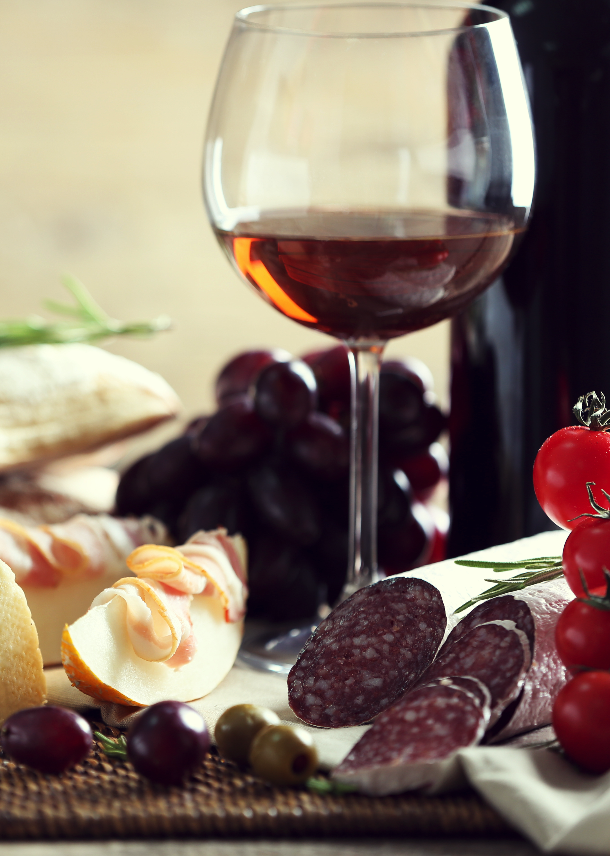Barolo and Barbaresco both command high prices and respect. They cellar well and often form a significant portion of a serious collector’s cellar. What makes Barolo different from Barbaresco? Are they grapes as well as wine names? What do they taste like? This post serves as an introduction to these beautiful wines.
The Piedmont
Barolo and Barbaresco wines take their name from villages in the northwestern Italian region known in English as the Piedmont. In Italian, they drop the “d” and add an “e” to the end making the word “Piemonte” (“pee-ah-MONT-eh”). Piemonte means “at the foot of the mountains,” referring to the nearby Alps, which provide a stunningly beautiful backdrop for the vineyards. Many wines originate in the Piedmont, but Barolo and Barbaresco surpass all others for fame and price.

Nebbiolo
Barolo and Barbaresco only contain one grape, Nebbiolo, which has grown in the Piedmont since at least 1266. Nebbiolo has a deceptively light color – reminiscent of Pinot Noir – and perfumed aromas of tart red fruit and roses. The palate, by contrast, shows a dense and tannic mouthfeel with earthy notes adding complexity and gravitas to the overall experience of the wine. The word “Nebbiolo” may originate from the word “Nebbia,” meaning “fog,” for the mists that settle over the vineyards in cooler weather.
Traditional vs. Modern Style
Originally a rich, viscous, sweet wine, Barolo established a reputation for wine long before Barbaresco. Currently, the word “traditional” refers to a Barolo or Barbaresco made in the style of the mid-twentieth century, when grapes were harvested late, put through long macerations, and aged in large oak barrels for many years. In other words, the traditional style tastes extremely dry and tannic, requiring many years of aging, both in barrel and bottle, to soften and become drinkable. The traditional style features restrained fruit flavors balanced against prominent not fruit notes like leather, tobacco, tar, earth, herbs, or mushrooms. Since the traditional barrels are large and used for decades, they impart none of the flavors typically associated with oak, like vanilla and baking spice.

“Modern” style Barolo and Barbaresco borrow techniques from other parts of the world, like France and the United States, such as fermenting in temperature-controlled stainless steel tanks and aging in new, small oak barrels – leading to wines that are softer, more fruit-forward, and easier to drink when young. Oak plays a role in the bouquet with the previously mentioned vanilla and spice accenting the characteristics of the Nebbiolo grapes. In decades past, modern and traditional winemakers argued passionately about the merits of the two styles, but today, the lines are blurred with wineries choosing aspects of the two styles depending on their individual stylistic goals.
Barolo
The village of Barolo has a population of fewer than 1,000 people and serves as a picturesque, quiet home for one of the world’s most famous wines. The area around Barolo can be roughly divided into two categories based on soil type. In the west, calcareous marls from the Tortonian period dominate the soil and are said to produce slightly lighter wines with elegance and finesse. The eastern part of Barolo has poorer, rockier soil said to be responsible for powerful, tannic wines with an even long cellar life. Many of the best vineyard sites feature southern exposure, good drainage, and moderate elevation, leading to the establishment of a Burgundy-esque system for vineyard classification. A list of cru vineyard sites was compiled by Barolo magnate Renato Ratti in 1979 which is still in use today, but official classification is not nearly as detailed as some would like. Barolo is among the longest lived wines in the world and makes an excellent addition to any cellar or dinner table. Barolo must be aged for 38 months, 18 of which must be in oak.

Barbaresco
The village of Barbaresco lies to the north of Barolo and makes wines from Nebbiolo that are nearly identical to Barolo in blind tasting. Barbaresco has far less vineyard area than Barolo and is said to have a slightly lighter style. The first Barbaresco was labeled in 1894, but the region didn’t gain international recognition until the 1970s when Angelo Gaja put it on the map. Gaja, whose family had been in the wine business since 1856, was among the first “modern” producers, taking over the family business in the 1960s and applying international production techniques to the wine. Barbaresco requires less aging than Barolo, with 26 months minimum aging – at least 9 of those months in oak.
Food Pairings
Barolo and Barbaresco can be paired interchangeably with the same foods. They make for an incredible complement to foods from the Piedmont region, like veal or beef braised in wine, pasta with porcini mushroom ragu, gnocchi stuffed with sausage, hard cheese like Grana Padano, and of course an appetizer plate featuring cured meats and truffles.




